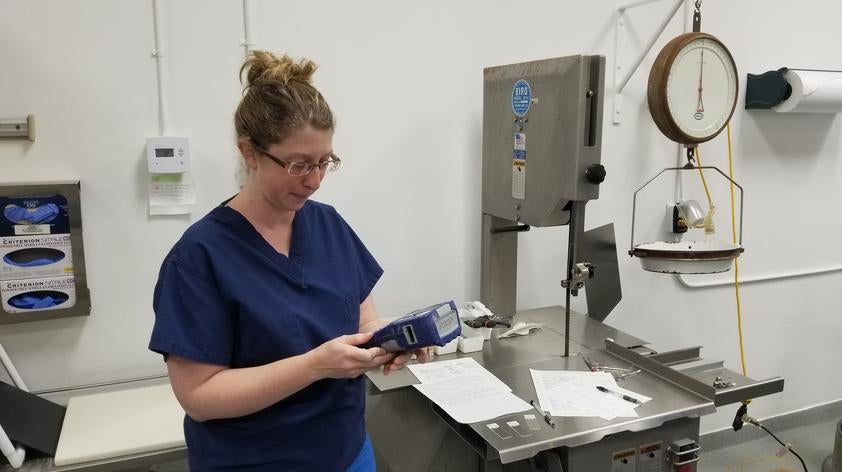
Pathology stories part two: A day in the life of Rachael Keeler
The necropsy lab is bright and gleams with stainless steel. Rows of tools hang along the side wall, and countertops with equipment ranging from tiny scalpels to microscopes to stacks of sample containers stand opposite. The ceilings are high and natural light lends this space a near glow. This is where Rachael Keeler works as a necropsy technician, one of only a handful working in zoological institutions nationwide.
“Just because an animal dies,” she says, “it doesn’t mean that’s the end.”
Rachael’s day starts early in the morning with her son, who wakes up before the alarm, and then breakfast with her family before arriving at the Zoo around 8:15 in the morning. She checks her email, looks in on the necropsy lab files to get a feel for what the day will look like, and then heads to the histology lab to set up her projects for the day. At 10:15am she attends rounds, where the team reviews everything from the day before and plans the day ahead. The team splits after rounds and either heads to the necropsy lab or back to histology for the day. If she’s heading to necropsy, Rachael takes any students she is currently mentoring with her and they work through the day’s specimens, starting with collection animals and then working through from largest to smallest, until lunch at 1:00pm. After lunch, she heads back into necropsy to finish what’s left for the day, including writing any reports and closing as much as possible before the end of the day.
If it’s a histology day, Rachael’s job includes managing the tissue slide archives that are maintained by the team and “trimming in” the samples taken at necropsy. Trimming in involves taking tissue samples and cutting them into small blocks, 2-3cm square, and then putting them into wax in order to preserve them long-term. Thin slices are taken from the blocks, and that is what is stained and put onto a slide to be used for diagnosis. The extensive samples represent every organ system so the pathologists can do full-scale diagnostics on every case.
Rachael has been part of the Disease Investigations team for seven years, though her interest in the field goes back much further. During her undergraduate program in Maine, she began doing food preparation and cleaning as a freshman. Soon she was pulled into necropsy, planting the seeds for her future career. After school she moved home to San Diego, where she volunteered at the Pacific Marine Mammal Center’s hospital. Their veterinarian at the time was a parasitologist and introduced her to what happens to tissues after death, sparking her fascination in the field. Several years later when a job opened in Disease Investigations, she joined the team and has been here ever since.
What does she like most about the job? “It’s my turn to close the chapter [on that animal’s life],” she says. “People want an answer and veterinarians want an answer [to why an animal has fallen ill or died] and I’m going to do what I can to facilitate that. I think that’s really cool. [This job is] all about art, it’s all about knowing what is normal, what colors are normal, what textures are normal, what sizes and shapes are normal, and I really like that aspect of the job more than I realized it.”
She loves working with her hands every day. She is artistic, and doesn’t feel that she is meant for a desk job, but in the necropsy lab she can be “on the floor” with something new to discover every day. Every case is like an investigation, where there is a mystery to solve: when animals die, there is always the question of what caused it, and it is the job of the necropsy technician to ask the question of why this happened. They quite literally put the “investigation” in Disease Investigations.
There are very few zoos with pathology teams, and most send samples away to remote labs. Rachael’s job doesn’t really exist anywhere else but on this team, and it is a treasured role. The pathologists are busy with their research and writing and investigations, so the technical work on the floor would take away from their work; by having Rachael and the other necropsy technicians, it frees them up to focus on their research, writing, and other projects.
The other advantage of having on-site pathology at a zoo is the positive impact on animal welfare. One recent example involved blue chinned sapphire hummingbirds (Chlorestes notata) that unexpectedly came to necropsy shortly after they had arrived to San Diego Zoo from Trinidad. The birds had done well before, but their health took a sudden turn after arriving in the collection.
Surprisingly, the birds looked normal at necropsy. The team was expecting drastic body changes, like little to no fat, to explain their sudden demise. Then one of the pathologists noticed that changes in the tissue under the microscope closely resembled a vitamin deficiency. Frozen tissue samples were sent out to a diagnostic testing facility which found that the tissues were deficient in vitamin A. A simple fix to the birds’ diet helped the rest of the hummingbirds suddenly thrive: successful animal welfare improvements coming directly through Disease Investigations.
Rachael’s workday ends around 4:45 in the afternoon, when she heads home to dinner with her family. She plays with her son before putting him to bed and then keeps her hands busy doing something artistic, maybe calligraphy or watercolors, before it’s time for bed. In the morning she’ll get up and do it all again, uncovering the mysteries that have arrived overnight.
Thanks so much to Rachael Keeler for taking the time to speak with me and share about her work. You can learn more about Rachael through her profile on the Institute for Conservation Research website.













